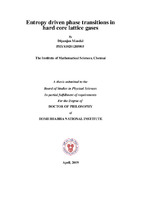- DSpace Home
- →
- IMSc Theses/ Dissertations
- →
- IMSc Theses/ Dissertations
- →
- View Item
JavaScript is disabled for your browser. Some features of this site may not work without it.
| dc.contributor.author | Dipanjan Mandal | |
| dc.date.accessioned | 2019-07-30T10:53:54Z | |
| dc.date.available | 2019-07-30T10:53:54Z | |
| dc.date.issued | 2019 | |
| dc.date.submitted | 2019 | |
| dc.identifier.uri | https://dspace.imsc.res.in/xmlui/handle/123456789/443 | |
| dc.description.abstract | Entropy driven phase transitions are often observed in nature e.g., freezing transition in hard sphere, disordered-nematic transition in suspension of tobacco mosaic virus, etc. Hard core lattice gas models are minimal models to study entropy-driven phase transitions where particles interact only through excluded volume interactions. The phases and phase transitions depends only on the shape and density of the particles. Despite a long history, it is not understood what the precise dependence between the shapes of the particles and the emergent phases is. In this thesis we study in detail four hard core lattice gas models, (a) 2x2 squares, (b) mixture of 2x1 dimers and 2x2 squares on square lattice, (c) 2x2x1 plates on cubic lattice and (d) Y-shaped particles on triangular lattice. The hard square lattice gas model on a square lattice is known to undergo a continuous phase transition from a low density fluid-like phase to high density phase with columnar. We estimate the critical activity by calculating, within an approximation scheme, the interfacial tension between two differently ordered columnar phases, and then setting it to zero. The estimated results are in good agreement with existing Monte Carlo simulation results, and is an significant improvement over earlier best estimates. We extend the hard square model to a mixture of hard squares and dimers on a square lattice. The model is known to undergo a transition from a low- density disordered phase to a high-density columnar ordered phase. We estimate the phase boundary separating the ordered and disordered phases using the interfacial tension method within two different approximation schemes. The analytically obtained phase boundary is in good agreement with Monte Carlo simulations. We further generalise the hard square model on three dimensional cubic lattice. We study the different phases and the phase transitions in a system of 2x2x1 hard plates in three dimensional cubic lattice. Using grand canonical Monte Carlo simulations we have shown that the system undergoes two density driven transitions with increasing the density of the particles, which are disordered-layered and layered-sublattice transition. We have shown that the disordered-layered transition is of second order while the layered-sublattice transition is of first order in nature. Finally, we consider hard Y-shaped particles on a triangular lattice. We show that the system undergoes two transitions with increasing the particle density. At low density the system is in a disordered phase. With increasing particle density the system undergoes two entropy driven phase transitions which are disordered-sublattice and sub lattice-columnar. Using finite size scaling we have shown that both transitions are first order in nature. | en_US |
| dc.publisher.publisher | The Institute of Mathematical Sciences | |
| dc.subject | Phase Transition | en_US |
| dc.subject | HBNI Th155 | en_US |
| dc.title | Entropy driven phase transitions in hard core lattice gases[HBNI Th155] | en_US |
| dc.type.degree | Ph.D | en_US |
| dc.type.institution | HBNI | en_US |
| dc.description.advisor | Rajesh Ravindran | |
| dc.description.pages | 146p. | en_US |
| dc.type.mainsub | Physics | en_US |
| dc.type.hbnibos | Physical Sciences |
Files in this item
This item appears in the following Collection(s)
-
IMSc Theses/ Dissertations
IMSc Theses/ Dissertations
